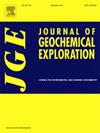Formation mechanism of high arsenic geothermal water in Gonghe basin, Northwest China
IF 3.3
2区 地球科学
Q1 GEOCHEMISTRY & GEOPHYSICS
引用次数: 0
Abstract
The occurrence of high arsenic (As) concentrations in groundwater within overlying aquifers, influenced by deep geothermal activities, has been reported globally. However, its genetic mechanisms remain inadequately understood. In this study, forty-one water samples were collected to analyze the major and trace chemical compositions of water, along with isotopic signatures (δ18O, δD, δ13C, δ14C, δ32SSO4). Results show that As concentrations in NGW (with an average 452 μg/L) are significantly higher than in QGW (with an average 36.0 μg/L). Additionally, hydrochemical type of QGW gradually evolves from Na-HCO3 to Na-SO4 and Na-Cl·SO4 along the flow path. The δ18O and δD isotopic results suggest that local atmospheric precipitation is the primary source of QGW, while glacial meltwater or high altitude atmospheric precipitation serves as the main source of NGW. The high temperature environment contributes to an oxygen drift in the δ18O of NGW. Results of δ13C indicate that the main sources of inorganic carbon in geothermal water are likely from the dissolution of carbonates and decomposition of organic matter. According to δ14C data, the average apparent age of QGW is 18.8 ka, with relatively older ages found in the south and southeastern parts of the study area, whereas NGW has an average age of 29.1 ka. The continuous upwelling of deep geothermal energy raises the temperature of hot storage aquifer, promoting the release and migration of As. Additionally, silicate weathering and microbial sulfate reduction play significant roles in As enrichment in both QGW and NGW. Furthermore, As desorption from QGW and NGW is another factor contributing to the elevated As levels in the investigated region.
共和盆地高砷地热水形成机制
受深层地热活动的影响,上覆含水层内地下水中砷浓度高的现象已在全球范围内得到报道。然而,其遗传机制仍未得到充分了解。本研究采集了41个水样,分析了水的主微量化学成分及同位素特征(δ18O、δD、δ13C、δ14C、δ32SSO4)。结果表明,NGW中As浓度(平均为452 μg/L)显著高于QGW(平均为36.0 μg/L)。QGW的水化学类型沿流道由Na-HCO3逐渐演变为Na-SO4和Na-Cl·SO4。δ18O和δD同位素结果表明,局地大气降水是QGW的主要来源,而冰川融水或高空大气降水是NGW的主要来源。高温环境导致了NGW δ18O的氧漂移。δ13C结果表明,地热水中无机碳的主要来源可能是碳酸盐的溶解和有机质的分解。根据δ14C数据,QGW的平均表观年龄为18.8 ka,研究区南部和东南部相对较老,而NGW的平均年龄为29.1 ka。深层地热能的持续上涌提高了储热含水层的温度,促进了As的释放和迁移。此外,硅酸盐风化作用和微生物硫酸盐还原作用在QGW和NGW的As富集中起重要作用。此外,QGW和NGW对As的解吸是导致研究区域As水平升高的另一个因素。
本文章由计算机程序翻译,如有差异,请以英文原文为准。
求助全文
约1分钟内获得全文
求助全文
来源期刊

Journal of Geochemical Exploration
地学-地球化学与地球物理
CiteScore
7.40
自引率
7.70%
发文量
148
审稿时长
8.1 months
期刊介绍:
Journal of Geochemical Exploration is mostly dedicated to publication of original studies in exploration and environmental geochemistry and related topics.
Contributions considered of prevalent interest for the journal include researches based on the application of innovative methods to:
define the genesis and the evolution of mineral deposits including transfer of elements in large-scale mineralized areas.
analyze complex systems at the boundaries between bio-geochemistry, metal transport and mineral accumulation.
evaluate effects of historical mining activities on the surface environment.
trace pollutant sources and define their fate and transport models in the near-surface and surface environments involving solid, fluid and aerial matrices.
assess and quantify natural and technogenic radioactivity in the environment.
determine geochemical anomalies and set baseline reference values using compositional data analysis, multivariate statistics and geo-spatial analysis.
assess the impacts of anthropogenic contamination on ecosystems and human health at local and regional scale to prioritize and classify risks through deterministic and stochastic approaches.
Papers dedicated to the presentation of newly developed methods in analytical geochemistry to be applied in the field or in laboratory are also within the topics of interest for the journal.
 求助内容:
求助内容: 应助结果提醒方式:
应助结果提醒方式:


